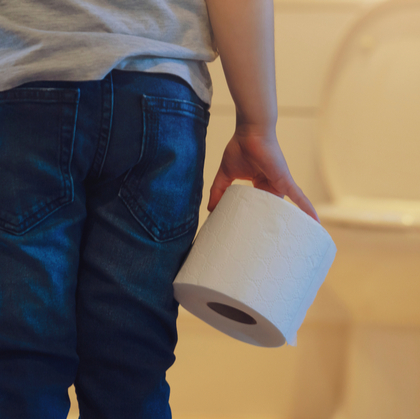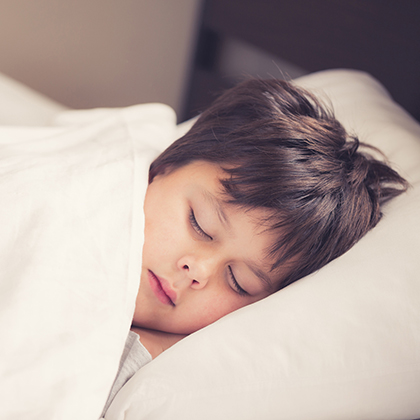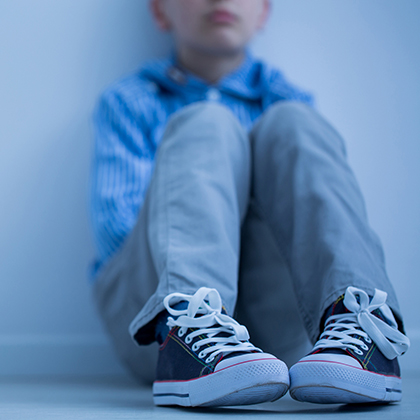
Attention deficit hyperactivity disorder (ADHD) is a common condition that – according to the American Psychiatric Association (i) – causes impulsive, hyperactive and inattentive behaviour. Children with ADHD are often labelled as ‘naughty’ or ‘disruptive’, but the truth is ADHD is a neurodevelopmental condition that can have a significant impact on the lives of the children who are affected by it as well as their families.
Despite the fact that it’s usually diagnosed in children under the age of 12 years (ii), ADHD isn’t exclusively a childhood problem, as many who developed it when they were children continue to experience symptoms when they’re grown up (for more details read our guide to adult ADHD). For this reason, ADHD is classed as a chronic lifelong disorder (iii).
What age does ADHD usually start?
ADHD symptoms can have a significant impact on children, creating problems for them at school as well as outside school. They often start to develop symptoms by the time they reach their sixth birthday, though a diagnosis of ADHD can formally be given to a child who develops symptoms any time before they reach the age of 12 years.
What are the signs of ADHD in a child?
The symptoms to look out for will depend on which type of ADHD a child has, though many will have symptoms of both types.
Types of ADHD
There are three different types of ADHD in children
-
Children who have difficulties concentrating and who are easily distracted or forgetful have the inattentive type – this accounts for up to 30 percent of cases
-
Children who are overactive, disorganised and who have difficulties controlling their urges have the hyperactive and impulsive type (15 percent)
-
Many have a combination of inattentive and hyperactive-impulsive behaviours (up to 75 percent) (iv)
Inattentive ADHD symptoms
If a child has the inattentive type of ADHD the main signs and symptoms include:
-
Short attention span
-
Being easily distracted
-
Forgetfulness
-
Making careless mistakes (with schoolwork, for example)
-
Frequently losing things such as school books and other materials, keys, mobile phones etc.
-
Reluctance to take part in or failure to finish time-consuming or tedious tasks
-
Frequently changing from one task or activity to another
-
Inability to follow or listen to instructions
-
Inability to organise tasks
Hyperactive-impulsive ADHD symptoms
Meanwhile the main signs and symptoms of the hyperactive-impulsive type of ADHD include:
-
Inability to sit still (or sit at all), particularly in quiet or calm environments
-
Inability to play or take part in activities quietly
-
Lack of concentration
-
Constant fidgeting
-
Excessive talking
-
Acting impulsively
-
Inability to understand risk or danger
-
Interrupting conversations
-
Inability to wait in turn
-
Excessive and inappropriate physical movement such as running around or climbing
How do you get an ADHD diagnosis?
Before a child can be diagnosed with ADHD they must have experienced several episodes of inattention and/or hyperactive-impulsive symptoms for at least six months, and have had symptoms in two or more different environments (for instance at home and school).
ADHD in toddlers
The same symptoms that appear in children with ADHD are present and can be noticed in toddlers. If you have a toddler that frequently fidgets, finds it hard to sit still and struggles to take turns talking it could be an early warning sign of ADHD. If you notice these symptoms in your child it may support the procurement of an earlier diagnosis.
ADHD child vs non-ADHD child
It is normal for many children to go through phases of bad behaviour. The difference between this type of normal behaviour and having ADHD is that a child without ADHD can behave properly when they want to, whereas a child with ADHD has no say in the matter (they simply can’t help themselves).
Meanwhile, it is sometimes the case that another physical and mental condition that could be causing similar symptoms to ADHD. These include:
-
Anxiety
-
Depression
-
Bipolar disorder
-
Personality disorders
-
Autistic spectrum disorder
-
Thyroid disease
-
Fetal alcohol syndrome
-
Oppositional defiant disorder and conduct disorder
-
Disruptive mood dysregulation disorder
-
Tic disorders (eg. Tourette’s disorder)
-
Hearing and vision problems (these can cause inattentiveness in younger children)
-
Specific learning disorders (an inability to read, for instance)
Experts involved in diagnosing ADHD in children have to be satisfied that a child's symptoms aren’t better explained by one of these other conditions.
Does ADHD go away?
ADHD is classed as a chronic lifelong disorder, but many of the symptoms often become milder as a child gets older – in general, hyperactive symptoms tend to improve, though inattentive symptoms often continue (vii). According to experts, around 65 in every 100 adults who had ADHD as a child find their symptoms have improved – though they usually still experience some difficulties because of their condition. Just 15 in 100 adults are still diagnosed as having ‘full’ ADHD (v).
The good news is getting treatment for ADHD can make a child’s day-to-day life far easier and less of a problem, particularly if treatment is started early
What causes ADHD in children?
ADHD is a complex condition and we don’t yet know exactly what causes it. Current thinking suggests there’s no single cause, but rather a combination of different factors that may trigger symptoms by affecting the brain’s chemistry and structure.
Some of the factors that might affect the brain changes or otherwise be involved in the development of ADHD include:
Genetics
According to NICE there’s strong evidence that ADHD is influenced by our genes – though probably several genes interacting rather than just a single gene (ix). This means a child may be more likely to develop ADHD if they have a close family member with the condition, such as a mother, father, sister or brother. Indeed, according to the NHS, ADHD does tend to run in families (viii).
Pregnancy and birth problems
According to Patient UK, women who drink alcohol, smoke or take heroin while they’re pregnant may have a higher risk of having a child who will go on to develop ADHD (v). Difficulties that happen during childbirth can also affect a baby’s chances of developing ADHD when they’re older, including labour problems that cause a lack of oxygen in the baby’s brain. If a baby is born with a very low birth weight or prematurely they too may be more likely to develop ADHD.
Meanwhile, other factors linked with ADHD include experiencing severe neglect early in life, having a brain injury (either in the womb or later in life), being exposed to lead, being deficient in iron and having epilepsy
The ADHD brain
Research has found that there are differences in the brain in people with ADHD compared with those who don’t have the condition, with some studies discovering certain areas of the brain can be smaller or larger in people with ADHD (v). Scientists elsewhere have found an imbalance of brain chemicals called neurotransmitters in people with ADHD, with others suggesting people with ADHD have neurotransmitters that don’t function properly (viii).
ADHD treatment
If your GP thinks your child may have ADHD they’ll likely refer your child to a specialist who can assess them and confirm whether or not they do have the condition. Waiting lists for assessments can be long, so in the meantime, you may be offered support such as a parent training or education programme.
Once a formal diagnosis is in place, your specialist or GP will arrange treatment for your child. It’s important to arrange this as early as possible, since ADHD can cause significant problems – for instance, according to Patient UK children with ADHD who don’t have treatment are up to 100 times more likely to be excluded from school (v). ADHD is also one of the main risk factors for criminal behaviour during childhood.
The treatment your child receives will depend on things like their age and how severe their symptoms are. Many treatment options include the following:
ADHD therapy
If your child has mild to moderate symptoms you may both be advised to take part in a training programme that can help you cope better with their condition, including ways of managing problem behaviour, understanding your child’s behaviours and emotions, and how to communicate with them more effectively. Other therapy options include family therapy, social skills training, behaviour therapy and cognitive behavioural therapy (CBT). Some therapies are carried out with a therapist individually while others take place in groups.
ADHD music therapy
Sometimes called sound therapy, this type of therapy involves having a child listen to music while completing memory or attention-requiring tasks. Researchers believe that music helps increase the release of dopamine in the brain, which is usually very scarce in ADHD brains. Dopamine is the chemical responsible for helping people regulate attention, memory and motivation to work. By listening to music while completing these tasks it may help boost the ability of ADHD children to complete attention-hungry tasks like homework and chores.
ADHD medicine for kids
Several medicines are used to treat ADHD in children aged six years and older. If your child is prescribed any of them they will be supervised by a specialist. The most common medicine used is methylphenidate, which you may know by its brand name Ritalin. Other medicines can be tried if methylphenidate hasn’t been effective or is not suitable.
Methylphenidate works by increasing the amount of a brain chemical called dopamine in certain parts of the brain, stimulating those areas to work better. The main aims of taking methylphenidate include improvements in concentration and attention. As with all medicines, however, there is an increased chance of experiencing side effects. But the benefits of taking methylphenidate are thought to frequently outweigh any potential risks.
If your child starts taking ADHD medication it’s a good idea to be aware of any of the side effects they may experience, so you know what to look out for.
How to support a child with ADHD
Having a child with ADHD can at times turn your life upside down and make the things you do as a family every day more of a challenge. There is, however, lots of support you can get from health professionals and charities such as the ADHD Foundation and the National Attention Deficit Disorder Information and Support Service (ADDISS).
Your child can also get extra support at school from their teachers or the school’s special educational needs coordinator (SENCO).
How do you talk to a child with ADHD?
There are lots of things you can do too that could help make life go more smoothly. Some of the things recommended by the Royal College of Psychiatrists include (x):
-
Give your child simple, specific instructions and speak to them slowly and calmly.
-
Praise them when they have done something you wanted them to do, even when it seems like a relatively minor task.
-
If necessary write down a list of the things you want them to do and put it somewhere they can see it clearly.
-
Break up tasks into small chunks of 15 - 20 minutes at a time (eg. homework or sitting at the dinner table).
-
Get them involved in regular fun activities that will use up some of their excess energy.
Some of the other things you could try include establishing routines they can follow easily and planning their day clearly, so they know exactly what to expect. Having a regular bedtime routine can be especially helpful, as many children with ADHD have problems with sleep. Meanwhile, if you notice they’re becoming frustrated or about to lose their self-control, take action straight away – for instance, quickly taking them out of a situation that may be overstimulating them could be all they need to feel calmer.
How can certain foods make ADHD worse?
The Royal College of Psychiatry suggests changing a child’s diet to avoid additives (x). Its experts claim there’s some evidence about the effect of diet on certain children with ADHD, as they may be sensitive to some food colourings and additives. Some of the additives and colourings that have been linked to ADHD symptoms include:
-
E102 Tartrazine
-
E110 Sunset Yellow
-
E122 Azorubine/Carmoisine
-
E133 Brilliant Blue
-
E211 Sodium benzoate
Caffeine can also affect some children’s behaviour – this can be found in tea, coffee, fizzy drinks and chocolate – while artificial sweeteners such as aspartame, saccharin and cyclamate may sometimes also cause problems.
If you suspect some foods are making your child’s hyperactivity worse it’s a good idea to avoid them. However, discuss this with your GP first, as you may need the help of a dietitian before cutting out any foods from your child’s diet.
Otherwise, try to make sure your child eats a healthy balanced diet with limited snacks and foods high in fat and/or sugar. Try to have meals and snacks at regular times, as set routines can often help a child with ADHD cope with life better, and if possible make sure there aren’t lots of distractions while you’re eating
Supplements for ADHD in children
You may also want to consider giving your child a multivitamin and mineral supplement to help make sure they’re getting all the important nutrients they need, as even children with an ideal diet have an off day now and then. Look for a good-quality multivitamin and mineral supplement that’s formulated for your child’s age group that provides all the important nutrients they need to support their physical and mental health. You may also find it useful to give them a sugar-free chewable multivitamin or a supplement that dissolves in water to make a tasty fizzy drink (check the ingredients list first as some may contain additives or artificial sweeteners).
You may also want to try an omega-3 supplement, as there is some evidence these fatty acids may benefit children with ADHD, especially those who are deficient in omega-3s.
One study carried out by researchers at King’s College London and China Medical University in Taiwan, for instance, has found children with ADHD who have low blood levels of omega-3 experienced better attention after taking omega-3 supplements for 12 weeks compared to those taking a placebo (dummy pill) (xi). However, the children who already had normal or high levels of omega-3 to start with didn’t enjoy any such improvements, the researchers add.
You can increase the omega-3 content in your child’s diet by giving them meals containing oily fish such as salmon, sardines, pilchards, herring or mackerel. According to the NHS boys can eat up to four portions of oily fish a week, but it’s best not to give girls more than two portions a week, as oily fish contain pollutants that may harm a future pregnancy (xii). If you want to give your child a supplement, look for one that’s suitable for your child’s age. If they don’t like swallowing tablets there are tasty chewable omega-3 supplements available designed to appeal to children.
Learn more about children's health
Having a child with ADHD can make life a challenge – not just for them but for you and the rest of your family too. If you think your child is affected it’s important to get a diagnosis as soon as possible , since early treatment can improve their life now and in the future. It’s also important to take up all the support on offer from your GP and other health professionals, as there are lots you can learn that could help make life for you and your child more normal. Find out more about children’s health conditions by visiting our health library’s children’s health section.
References:
-
Available online: https://www.psychiatry.org/psychiatrists/practice/dsm
-
Available online: https://www.nhs.uk/conditions/attention-deficit-hyperactivity-disorder-adhd/
-
Bjork, A. et al., Health, lifestyle habits, and physical fitness among adults with ADHD compared with a random sample of a Swedish general population. Society, Health & Vulnerability. 2018;9(1). Available online: https://www.tandfonline.com/doi/full/10.1080/20021518.2018.1553916.
-
Available online: https://cks.nice.org.uk/topics/attention-deficit-hyperactivity-disorder/background-information/prevalence/
-
Available online: https://patient.info/childrens-health/attention-deficit-hyperactivity-disorder-adhd
-
Available online: https://www.nice.org.uk/guidance/ng87/chapter/Recommendations#recognition-identification-and-referral
-
Available online: https://cks.nice.org.uk/topics/attention-deficit-hyperactivity-disorder/background-information/prognosis/
-
Available online: https://www.nhs.uk/conditions/attention-deficit-hyperactivity-disorder-adhd/causes/
-
Available online: https://cks.nice.org.uk/topics/attention-deficit-hyperactivity-disorder/background-information/causes/
-
Available online: https://www.rcpsych.ac.uk/mental-health/parents-and-young-people/information-for-parents-and-carers/ADHD-and-hyperkinetic-disorder-information-for-parents
-
Chang, JPC et al., High-dose eicosapentaenoic acid (EPA) improves attention and vigilance in children and adolescents with attention deficit hyperactivity disorder (ADHD) and low endogenous EPA levels. Translational Psychiatry. 2019 Nov 18;9(1):303.
-
Available online: https://www.nhs.uk/live-well/eat-well/food-types/fish-and-shellfish-nutrition/
Related Posts
Disclaimer: The information presented by Nature's Best is for informational purposes only. It is based on scientific studies (human, animal, or in vitro), clinical experience, or traditional usage as cited in each article. The results reported may not necessarily occur in all individuals. Self-treatment is not recommended for life-threatening conditions that require medical treatment under a doctor's care. For many of the conditions discussed, treatment with prescription or over the counter medication is also available. Consult your doctor, practitioner, and/or pharmacist for any health problem and before using any supplements or before making any changes in prescribed medications.

Christine
Christine Morgan has been a freelance health and wellbeing journalist for almost 20 years, having written for numerous publications including the Daily Mirror, S Magazine, Top Sante, Healthy, Woman & Home, Zest, Allergy, Healthy Times and Pregnancy & Birth; she has also edited several titles such as Women’ Health, Shine’s Real Health & Beauty and All About Health.
View More



